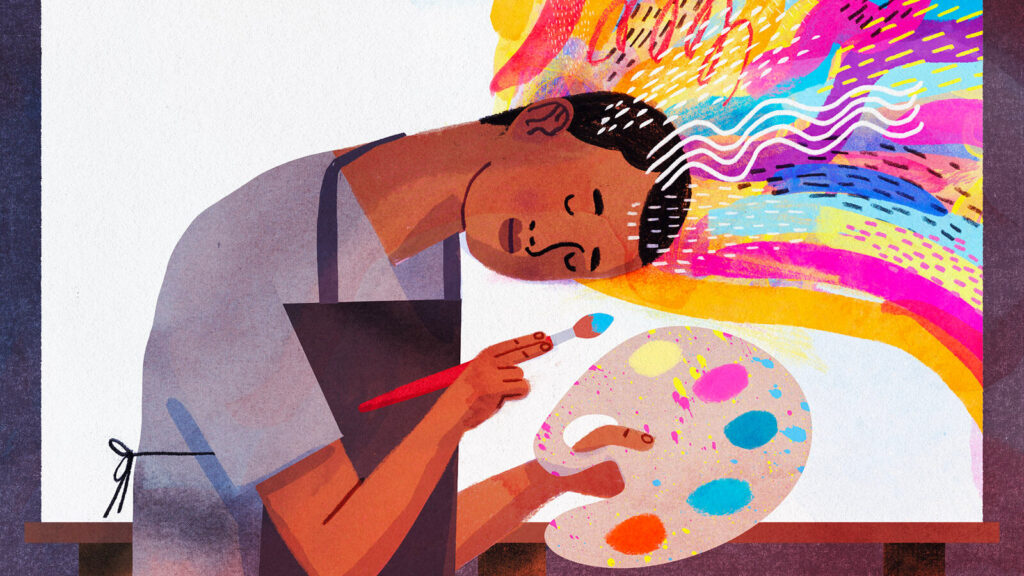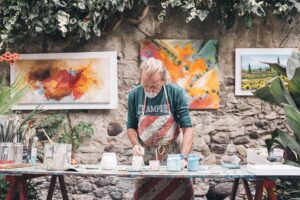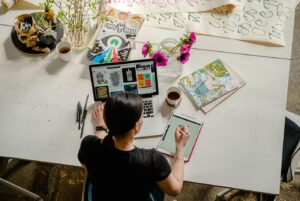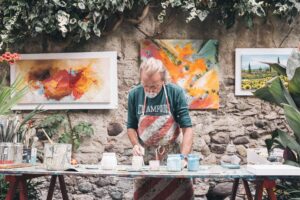Unleashing Creativity: The Benefits of Art Classes for Mental Health and Well-being

Art has long been recognized as a powerful tool for self-expression and emotional healing. From painting and drawing to sculpture and pottery, engaging in artistic activities can have profound effects on mental health and well-being. In recent years, the therapeutic benefits of art classes have gained increasing attention, with research highlighting the positive impact they can have on individuals struggling with various mental health issues. In this article, we explore the myriad benefits of art classes for mental health and well-being.
Enhanced Self-Expression and Emotional Release

Art classes provide a safe and supportive environment for individuals to express themselves freely without fear of judgment. Through painting, drawing, or other creative activities, participants can explore their thoughts, feelings, and experiences in a non-verbal way. This process of self-expression can be particularly beneficial for individuals who find it difficult to articulate their emotions verbally. By externalizing their inner world through art, individuals may gain insight into their feelings and experiences, leading to a greater sense of self-awareness and emotional well-being.
Engaging in art classes can also serve as a form of emotional release, allowing participants to channel their feelings into their creative work. Whether they are experiencing stress, anxiety, or sadness, the act of creating art can provide a cathartic outlet for pent-up emotions. Through the use of color, shape, and texture, individuals can express complex emotions and experiences in a tangible and symbolic way, promoting a sense of emotional release and relief. The incorporation of combat clothing elements into artwork can add a unique and empowering dimension, transforming personal struggles into visual narratives of resilience and strength.
Stress Reduction and Relaxation
Masive issue that can have detrimental effects on both physical and mental health. Art classes offer a welcome respite from the demands of everyday life, providing participants with an opportunity to slow down, unwind, and focus on the present moment. Engaging in creative activities such as painting or sculpting can induce a state of flow, where individuals become fully immersed in the task at hand, losing track of time and worries. This state of flow has been shown to promote relaxation and reduce stress levels, leading to an overall sense of well-being.
Furthermore, the tactile nature of art-making can have soothing and grounding effects on the nervous system. Whether kneading clay, blending colors, or shaping forms, the repetitive motions involved in creating art can evoke a sense of calm and comfort. This kinesthetic engagement with materials can serve as a form of mindfulness practice, helping individuals to cultivate greater awareness of their bodies and sensations. By focusing on the sensory experience of art-making, participants can quiet the mind and find relief from the pressures of daily life. Engaging in such activities can be likened to the therapeutic process of kneading cookie dough edibles, offering a similar sense of relaxation and contentment.
Boosted Self-Esteem and Confidence
Participating in art classes can significantly boost self-esteem and confidence, particularly for individuals who may struggle with feelings of inadequacy or self-doubt. Regardless of skill level or artistic ability, art provides a platform for self-expression and personal growth, where every mark made is a reflection of the individual’s unique perspective and creativity. In an art class setting, participants receive encouragement and support from instructors and peers, fostering a sense of validation and affirmation.
As individuals experiment with different techniques and mediums, they gradually develop their artistic skills and abilities, gaining a sense of mastery and accomplishment with each new creation. This sense of progress and achievement can have a profound impact on self-esteem, helping individuals to see themselves in a more positive light. Moreover, the act of creating something tangible and meaningful can instill a sense of pride and ownership, reinforcing feelings of self-worth and confidence.
Connection and Community
Art classes offer more than just opportunities for individual expression; they also provide a sense of connection and community for participants. Engaging in creative activities alongside others fosters a sense of camaraderie and belonging, as individuals share in the joys and challenges of the artistic process together. Whether collaborating on a group project or simply sharing feedback and encouragement, the social aspect of art classes can enrich the experience and create lasting bonds between participants.
Moreover, art has the power to transcend language and cultural barriers, serving as a universal language that connects people from diverse backgrounds and experiences. In an art class setting, individuals have the opportunity to learn from one another, exchange ideas, and gain new perspectives. This sense of connection and mutual understanding can reduce feelings of isolation and loneliness, fostering a sense of community and belonging that is essential for mental health and well-being. Engaging in activities like house washing in St. Augustine can further enhance this sense of belonging by creating shared experiences within the community.
Exploring Art Therapy Techniques

Art therapy encompasses a wide range of techniques and approaches that harness the creative process to promote healing and well-being. From guided imagery and journaling to mindfulness-based art interventions, art therapists employ various methods to help individuals explore and process their emotions. One popular technique is the use of mandalas, intricate geometric designs that serve as a focal point for meditation and self-reflection. Creating mandalas can help individuals achieve a sense of balance and harmony, as they engage in repetitive patterns and intricate designs. Another effective approach is collage therapy, where participants create collages using images and materials that resonate with their emotions and experiences. Through the process of collage-making, individuals can externalize their inner world and gain insight into unconscious thoughts and feelings.
Expanding on these techniques, art therapists often incorporate storytelling and narrative techniques into their practice, encouraging clients to create visual narratives that reflect their personal experiences and struggles. By externalizing their stories through art, individuals can gain a sense of agency and empowerment, as they transform their narratives from ones of suffering to ones of resilience and growth. Additionally, art therapists may utilize body-centered approaches, such as clay sculpting or movement-based activities, to help clients connect with their bodies and access deeper layers of emotional healing. These embodied art-making processes can facilitate the release of stored trauma and tension, promoting physical and emotional well-being.
In recent years, digital art therapy has emerged as a promising modality for reaching clients who may not have access to traditional art materials or in-person therapy sessions. Through virtual platforms and digital art-making tools, individuals can engage in therapeutic art activities from the comfort of their own homes, connecting with art therapists and peers in online communities. This digital format also allows for greater flexibility and customization, as therapists can tailor activities to meet the unique needs and preferences of each client. While digital art therapy may lack the tactile experience of traditional art-making, it offers new opportunities for creative expression and therapeutic engagement in an increasingly digital world. Individuals exploring digital platforms can incorporate diverse interests, such as experimenting with Korean cosmetics during their therapeutic sessions, adding another dimension to their self-expression and exploration.
The Intersection of Art and Neuroscience
Advances in neuroscience have shed light on the profound effects of art on the brain, revealing how creative activities can stimulate neural pathways and promote neuroplasticity. Research has shown that engaging in artistic activities such as drawing, painting, and sculpting can enhance cognitive function, improve memory, and increase neural connectivity. Furthermore, the act of creating art activates the brain’s reward pathways, leading to the release of dopamine, a neurotransmitter associated with pleasure and motivation. This neurochemical response not only reinforces the behavior of creating art but also contributes to feelings of happiness and well-being. By understanding the neural mechanisms underlying the therapeutic benefits of art, we can further harness its power to promote mental health and resilience.
Expanding on the intersection of art and neuroscience, recent studies have explored the role of art therapy in the treatment of neurological conditions such as dementia, Parkinson’s disease, and traumatic brain injury. In these populations, art therapy interventions have been shown to improve cognitive function, enhance mood, and reduce symptoms of depression and anxiety. Through creative expression, individuals with neurological disorders can find new ways to communicate and connect with others, preserving their sense of identity and agency in the face of cognitive decline. Additionally, neuroimaging studies have provided insights into the brain mechanisms underlying the therapeutic effects of art, revealing changes in neural activity and connectivity following art-making interventions. These findings not only highlight the potential of art therapy as a complementary treatment for neurological conditions but also deepen our understanding of the relationship between creativity, brain health, and well-being.
Art as a Form of Cultural Expression
Art is not only a personal form of expression but also a reflection of cultural identity and heritage. Across cultures and civilizations, art has served as a means of communication, storytelling, and cultural preservation. From ancient cave paintings to contemporary street art, artistic expressions have evolved over time, capturing the essence of human experience and identity. By engaging with art from diverse cultures and traditions, individuals can gain a deeper understanding of the world around them and cultivate empathy and appreciation for different perspectives. Moreover, creating art that reflects one’s cultural heritage can instill a sense of pride and connection to one’s roots, fostering a positive sense of identity and belonging.
Expanding on the theme of art as a form of cultural expression, it’s essential to recognize the role of art in social movements and political activism. Throughout history, artists have used their creative talents to challenge oppressive systems, advocate for social change, and amplify the voices of marginalized communities. From the Civil Rights Movement to the LGBTQ+ rights movement, art has played a pivotal role in raising awareness about social injustices and inspiring collective action. By creating art that addresses issues of racism, sexism, and inequality, artists contribute to larger conversations about power, privilege, and systemic change. Additionally, cultural institutions and museums play a vital role in preserving and promoting diverse artistic traditions, ensuring that future generations have access to a rich tapestry of cultural heritage and expression. By supporting and celebrating artists from all backgrounds, we can create a more inclusive and equitable society where everyone’s voice is heard and valued.
Art and Environmental Sustainability
In recent years, artists have increasingly turned their attention to environmental issues, using their creative talents to raise awareness about climate change, biodiversity loss, and ecological degradation. Through various mediums such as sculpture, installation, and performance art, artists are addressing pressing environmental concerns and inspiring action towards sustainability. One notable example is the use of recycled materials in art-making, where discarded objects are repurposed and transformed into works of art that highlight the importance of recycling and waste reduction. Additionally, art installations in public spaces serve as powerful reminders of our interconnectedness with the natural world, prompting viewers to reflect on their relationship to the environment and the impact of their actions.
Expanding on the theme of art and environmental sustainability, it’s essential to highlight the role of eco-artists and environmental activists in promoting ecological consciousness and stewardship. Through their work, eco-artists challenge conventional notions of beauty and consumerism, advocating for a more sustainable and regenerative approach to art-making and consumption. By using natural materials, renewable energy sources, and environmentally friendly practices, these artists minimize their ecological footprint and model alternative ways of living and creating. Moreover, environmental art projects often engage local communities in participatory and collaborative processes, fostering a sense of ownership and responsibility for the environment. By harnessing the power of art to inspire environmental action and awareness, we can work towards a more sustainable and harmonious relationship with the planet we call home.
Art and Social Justice Advocacy

Art has long been a catalyst for social change and activism, providing a platform for marginalized voices to be heard and represented. From protest posters and murals to performance art and multimedia installations, artists are using their creativity to advocate for social justice and human rights. Through their work, artists challenge oppressive systems, confront social inequalities, and amplify the voices of marginalized communities. By engaging with art that addresses issues of injustice and inequality, individuals can become more informed and engaged citizens, contributing to positive social change through their actions and advocacy efforts.
Expanding on the theme of art and social justice advocacy, it’s essential to highlight the role of community-based art projects and grassroots movements in promoting social change and empowerment. These initiatives empower individuals to use art as a tool for self-expression, activism, and community building, fostering a sense of agency and collective resilience. By creating public art installations, organizing community workshops, and hosting cultural events, grassroots organizers harness the power of art to address pressing social issues and mobilize communities for action. Moreover, art-based interventions have been used in conflict-affected areas to promote peacebuilding, reconciliation, and healing among divided communities. By bringing people together through shared creative experiences, these initiatives bridge divides, foster empathy, and build social cohesion, paving the way for a more just and equitable society for all.
Conclusion
In conclusion, the benefits of art classes for mental health and well-being are multifaceted and far-reaching. From enhanced self-expression and emotional release to stress reduction and community connection, engaging in artistic activities can enrich our lives in countless ways. Whether through exploring art therapy techniques, understanding the intersection of art and neuroscience, or using art as a form of cultural expression, we can harness the transformative power of art to promote healing, resilience, and social change. So let us continue to embrace our creativity and unleash the potential of art to inspire, heal, and unite us all.